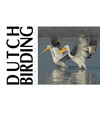Dutch Birding volume 29 (2007) no 3

Marbled Duck near Doornenburg and Pannerden in August 2004
On 14-16 August 2004, a Marbled Duck Marmaronetta angustirostris stayed near Doornenburg and Pannerden, Gelderland, the Netherlands. The bird was aged as a juvenile based on, among others, poorly contrasting pale markings on the upperparts, absence of obvious spotting on breast and flanks, and weakly developed crest. Because the bird had no signs suggesting a captive origin it was accepted by the Dutch rarities committee (CDNA) as the first record of this species for the Netherlands. There has been a handful of previous reports in the Netherlands, including some of presumed or proven captive origin, but none was fully documented and/or submitted.
The occurrence of Marbled Ducks in north-western Europe is analyzed to shed some light on the probable origin of the bird. A total of 61 reports (72 individuals) of which 51 (60 individuals) since 1980 were gathered from European countries east to Austria, Finland, Italy and Poland. The most northerly report is from southern Denmark and, apparently, the species is lacking from any list (A through E) of Finland, Ireland, Norway and Sweden. The reports show a strong peak in August-October and this coincides with the peak occurrence of the species in north-eastern Spain. The latter is thought to be the result of a northward dispersion of birds fleeing from drought in the breeding areas. This was probably also the driving force behind the movements of a Spanish ringed bird that was shot north-east of Lyon, France, in September 1992 (at c 1800 km distance from the ringing site). The occurrence of the species in western central Europe shows strong similarities to the occurrence in France and is compatible with a wild origin. It is concluded that vagrancy to western and central Europe is likely but only with low frequency because of the small size of the Spanish breeding population, where such vagrants are supposed to come from, although an eastern origin is also possible.
Numbers of Marbled Duck in captivity in Belgium and the Netherlands seem to have decreased strongly since 1991. Furthermore, all these birds legally have to be ringed since 1995 and, in addition, almost all are pinioned. The total number of unringed and not-pinioned individuals in captivity is believed not to exceed a few 10s of birds in these countries. According to consulted wildfowl breeders, Marbled Ducks kept in captivity show a reduced shyness. Wild birds captured as ducklings, reared to adulthood in captivity and then released into their natal areas also showed a notably reduced shyness. The species is very rare or absent in parks and similar 'open collections', presumably because it lacks an attractive plumage. In conclusion, the chances of an escaped individual to be unringed, shy and well flying like the Dutch bird in August 2004 seem to be small.
Rik Winters, Aquamarijnstraat 60, 9743 RB Groningen, Nederland (groenebijeneter![]() home.nl)
home.nl)
terug






